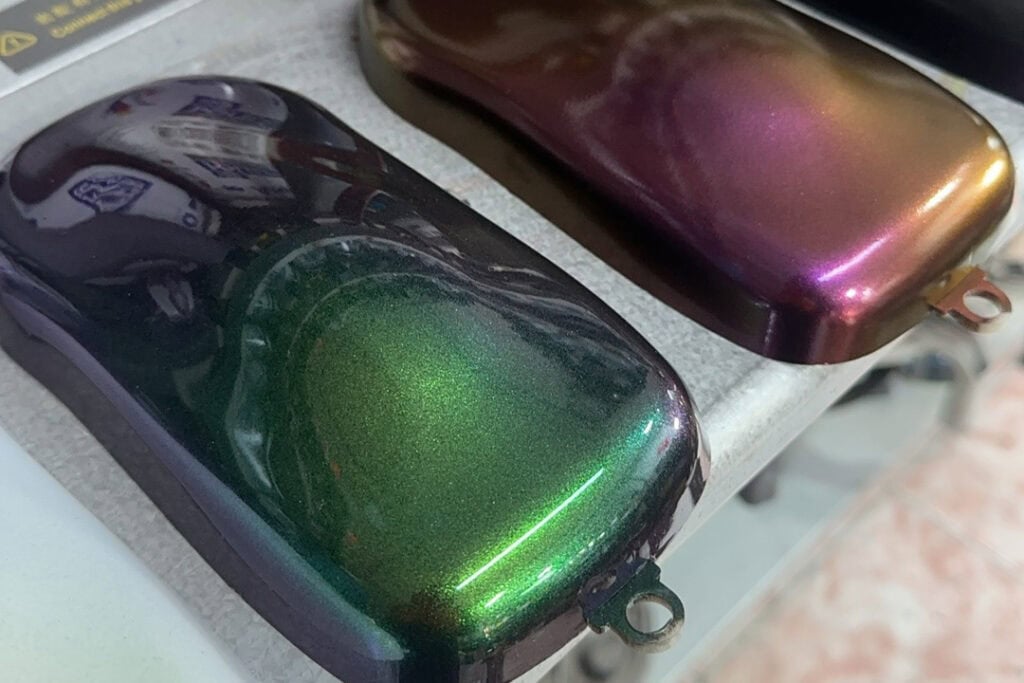Pearlescent pigments are pigments that reflect light to create an iridescent, pearl-like shimmer. These pigments are made by layering materials like mica with metal oxides (such as titanium dioxide). The multiple layers bend and reflect light at different angles, creating the illusion of depth and color, much like the natural effect seen on pearls, shells, and even butterfly wings.
A Brief History of Pearlescent Pigments
The use of pigments dates back thousands of years, but pearlescent pigments are a relatively modern development. Historically, natural pigments like ochres, iron oxides, and earth tones dominated until chemical synthesis advanced in the late 19th and early 20th centuries.
Pearlescent pigments emerged in the 20th century when scientists began experimenting with layering materials to create new color effects. Early forms were often derived from natural sources such as fish scales, which contain guanine crystals that reflect light in much the same way modern pearlescent pigments do. These pigments were prized for their ability to mimic the natural shimmer of pearls, leading to their widespread adoption in luxury goods.
By the mid-20th century, industrial production techniques improved, and companies began synthesizing pearlescent pigments using mineral substrates like mica coated with oxides, significantly expanding their applications across various industries.
The Science Behind Pearlescent Pigments
The shimmer effect of pearlescent pigments is a result of light interference. When light hits the surface of these pigments, it is reflected, refracted, and scattered by the multiple layers in the pigment. The most common materials used are mica (a naturally occurring mineral), titanium dioxide, and iron oxide.
- Mica serves as the base, or substrate, because it is transparent and can be easily coated with thin layers of other materials. When metal oxides are deposited on the mica, they create a reflective surface that interacts with light.
- The thickness of the oxide layers determines the colors produced. Thinner layers create soft, silvery effects, while thicker layers produce more intense, colorful reflections. This is why pearlescent pigments can exhibit different hues depending on the viewing angle, a property known as iridescence.
The combination of these materials allows pearlescent pigments to reflect a range of colors and create optical effects that add depth and movement to otherwise flat surfaces.
What Are the Applications of Pearlescent Pigments?
The versatility of pearlescent pigments makes them invaluable across a wide array of industries. Their shimmering, light-reflecting properties add an extra dimension to products, giving them a premium, luxurious appearance. Here’s a closer look at some of their key applications:
Cosmetics: Pearlescent pigments are widely used in makeup products such as eyeshadows, lipsticks, highlighters, and nail polishes. They give makeup a radiant glow and help create multi-dimensional looks by reflecting light. In particular, they are used to highlight areas of the face, such as the cheekbones and eyelids, to create a luminous, youthful appearance.


Automotive Industry: In the automotive world, pearlescent pigments are used to give car paint a glossy, iridescent finish. This type of paint shifts color depending on the angle of the light and the viewer’s perspective, adding a unique touch to high-end and luxury vehicles. Pearlescent car paints are more expensive than standard metallic paints, but their visual appeal makes them a popular choice for customization.

Packaging: Pearlescent pigments are frequently used in the packaging of luxury products like perfumes, electronics, and high-end food items. Their light-reflecting properties help create an impression of quality and elegance, making products more attractive to consumers. Packaging materials such as plastics, glass, and paper can all be treated with pearlescent pigments.

Decorative Coatings: These pigments are also used in coatings for furniture, home décor, and artworks. Interior designers often use pearlescent coatings to add a soft, reflective finish to walls, fixtures, and accessories. These pigments give surfaces a shimmering, elegant appearance that changes with the lighting conditions in the room.

Food and Beverages: Surprisingly, pearlescent pigments have also found their way into the food industry. Mica-based pearlescent pigments are FDA-approved for use in certain food products, such as candies, frostings, and cake decorations. These pigments are added to create sparkling effects in confections, enhancing the visual appeal of the products.

How Do You Use Pearlescent Pigments?
Using pearlescent pigments can vary depending on the industry and application. In general, these pigments are added to a medium—whether it’s paint, resin, plastic, or cosmetics—where they are evenly dispersed to create a consistent shimmer.
For example, in art, pearlescent pigments are often mixed into paints or varnishes to add depth and dimension to a piece. Artists and DIY enthusiasts use them to create everything from shimmering home décor items to jewelry.
When working with cosmetics, these pigments are ground into a fine powder and blended into creams, gels, or powders to ensure even application on the skin. Similarly, in automotive paints, pearlescent pigments are suspended in a clear coat to create that glossy, reflective finish.
What Are the Different Types of Pearlescent Pigments?
There are several types of pearlescent pigments available, each providing a different effect based on the material used. Some of the most common types include:
Natural Pearl Essence: Derived from fish scales, this is one of the oldest forms of pearlescent pigments and was used historically for its light-reflecting properties.
Mica-Based Pigments: These are the most common today. Mica is coated with metal oxides such as titanium dioxide or iron oxide to create various color effects. Mica-based pigments are widely used in cosmetics, automotive paints, and food applications.
Bismuth Oxychloride: This type of pigment is often used in high-end cosmetics for its soft, smooth finish. It provides a more refined shimmer compared to mica-based pigments.
Titanium Dioxide Flakes: These are used to create highly reflective surfaces, particularly in industrial applications such as automotive paints and decorative coatings.
Micaceous Iron Oxide: Known for its durability, this type of pigment is often used in industrial and protective coatings, especially for steel structures.
What Is Mica-Based Pearlescent Pigment Used For?
Mica-based pearlescent pigments are incredibly versatile and used across industries. In cosmetics, they provide a soft shimmer to products like eyeshadows, lipsticks, and blushes. They can also be found in personal care items such as lotions and shampoos, where they add a subtle glow to the product.
In the food industry, mica-based pigments are approved for use in limited quantities to add sparkle to candies, frostings, and gelatin desserts. They give confections an eye-catching appearance, making them more appealing to consumers.
Additionally, in paints and coatings, mica-based pigments are used to achieve brilliant, reflective finishes on everything from luxury cars to interior walls.
Conclusion
Pearlescent pigments are more than just a decorative tool—they’re a testament to the blend of science and artistry. From their origins in natural pearl essence to modern synthetic varieties, these pigments have become an essential part of industries as diverse as cosmetics, automotive, packaging, and even food. Their ability to reflect light in mesmerizing ways ensures they will continue to captivate us for years to come.
Whether you’re admiring the shimmer on a luxury car or applying a highlighter for a glowing look, pearlescent pigments are responsible for adding that extra touch of brilliance to our everyday lives.









